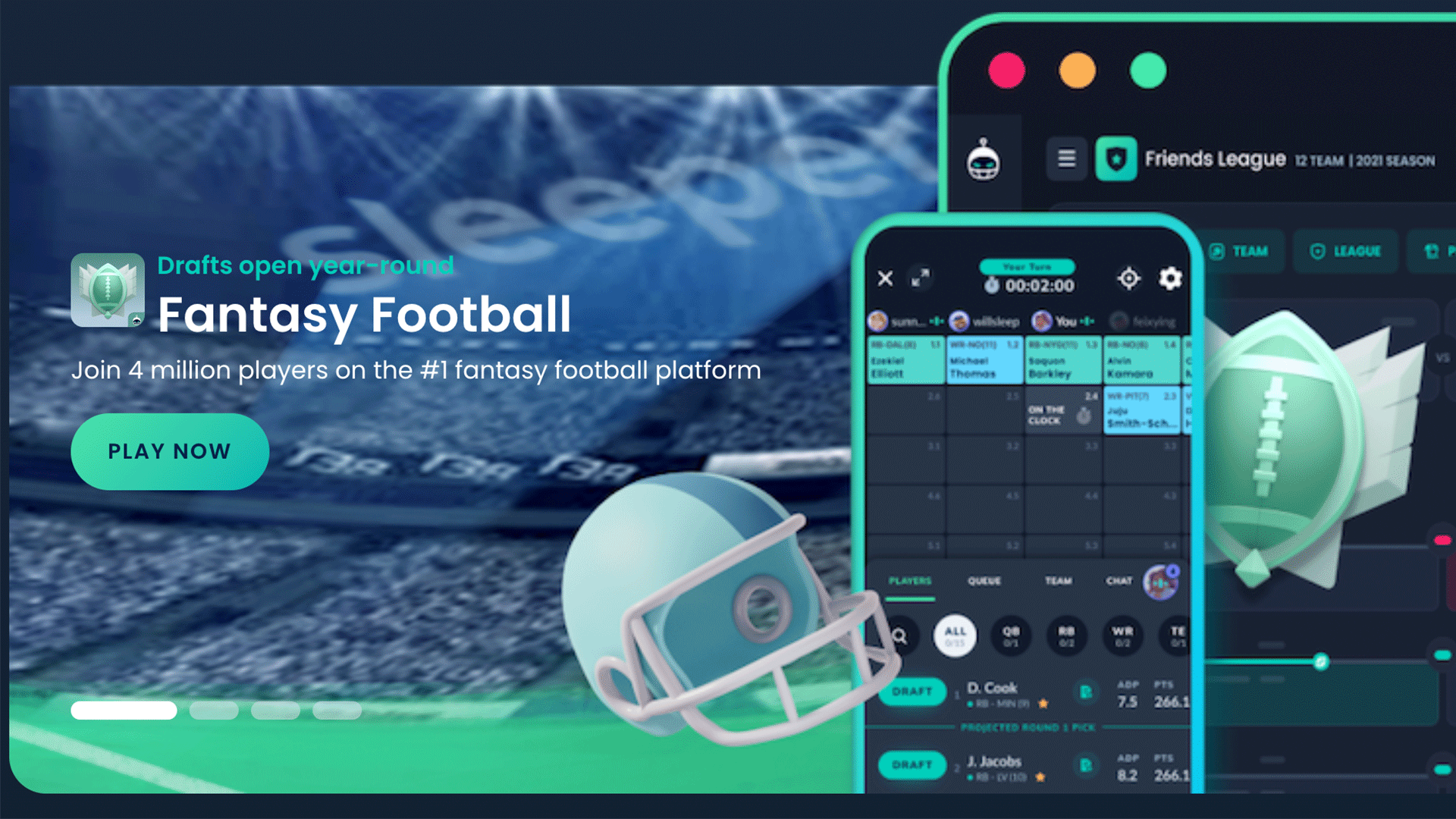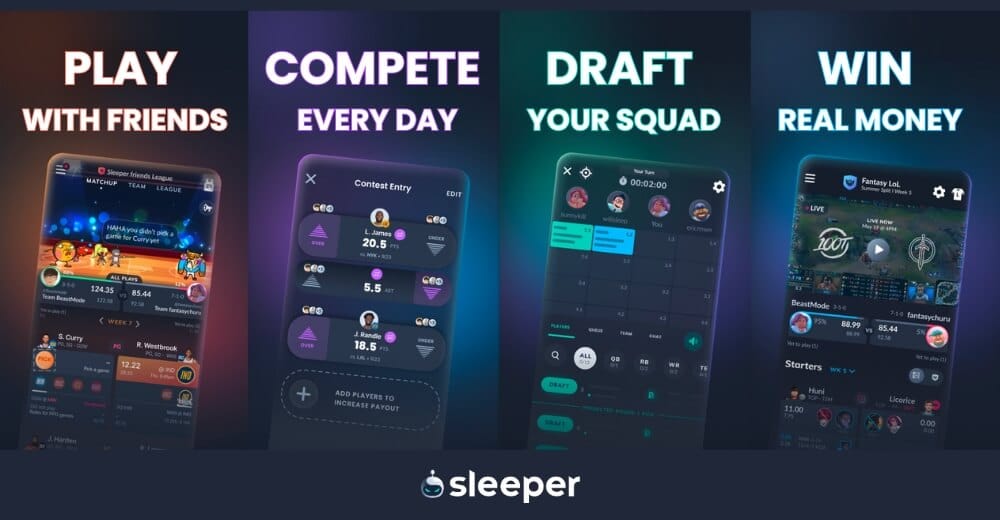Fantasy football is your chance to run your own football team. Draft players, make trades, decide who starts and who sits. It's all in your hands.
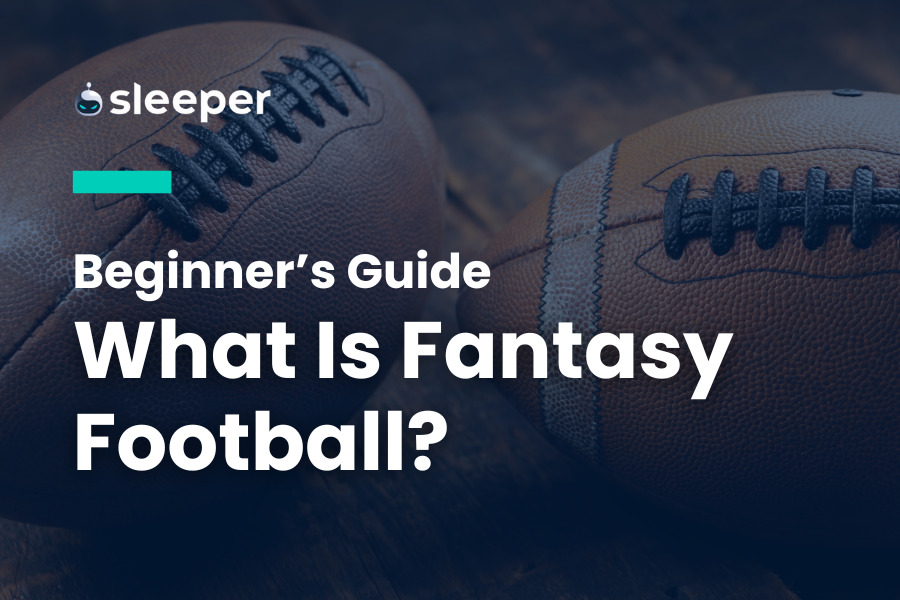
So you’re a newcomer to this crazy little game called fantasy football and you want to know what all the hype is about? Good news. After reading this article, you’ll be ready to join the nearly 30 million individuals who manage a fantasy football team each NFL season.
And your life will never be the same again.
In this brief guide, we’ll help you understand how fantasy football is played, and provide you with a firm grasp of concepts like leagues, drafts, and scoring systems. We’ll share the wisdom that comes from having participated in thousands of fantasy football drafts over the years, and it will only take a few minutes.
What do you have to lose?
What Is Fantasy Football & How Does it Work?
Let's start with a definition: Fantasy football is an engaging virtual game that lets you follow along with real NFL (or college football) games and rack up (fantasy) points based on real players’ actual, in-game performance.
Fantasy football adds to the in-game excitement of every single play, giving you a chance to root for not only your favorite NFL team, but a collection of eight to 12 individual players on your fantasy football team, too.
For example, if you’re a Philadelphia Eagles fan in real life, you’ll still want to watch (and root for) a running back on the Dallas Cowboys if he’s on your fantasy team. Should that Cowboys player score a touchdown, your fantasy football team would be rewarded with fantasy points. As a bonus, you can still root for the Cowboys to lose the game!
Fantasy football gives you the opportunity to play the role of a professional football GM. Based on how well you build, manage and maintain your roster, you'll have a chance to lead your fantasy team to glory, riches and season-long bragging rights.
Generally, people play fantasy football with their co-workers or friends, and the most popular version of the game is commonly called “redraft.” Every year, you get together with the other members of your league and re-draft a fantasy football team from scratch. If you play in a fantasy football league that’s been running for six years, you would have participated in six annual fantasy football drafts.
Let’s dive into the different draft and league types and outline some of the fun variations based on skill level and how much time you’re willing to commit to attaining fantasy football glory.
What Is a Fantasy Football League?
In short, a fantasy football league is a collection of 10 or 12 people — you, your friends or coworkers — each playing the role of fantasy general manager (GM) by drafting a team and competing against each other in pursuit of a championship. You’ll occasionally find leagues with eight, 14, or 16 participants, too.
However, unlike an NFL GM, fantasy managers only need to worry about the fun and easy parts of team management. The table below provides a quick comparison of fantasy managers and NFL GMs.
Fantasy football leagues typically have a commissioner. The “commish” is a league member who takes on additional administrative responsibilities such as scheduling draft dates, arbitrating member disputes and putting rules changes or proposals to a league vote. If your league has money or prizes on the line, it may be up to the commissioner to manage these activities as well.
Fantasy Football League Types
There are many different fantasy football league types, but we’ll cover the three most common below.
Redraft
Also known as “season long fantasy football,” redraft is where you draft a new team ahead of each NFL season. Most office fantasy football leagues and casual leagues with friends fall into this category. In fact, when people say “fantasy football” there’s a good chance they’re referring to this format, in which drafts typically last 15-18 rounds. Redraft leagues give you the ability to propose trades, put in waiver claims, and make start-sit decisions for your fantasy lineups each week, all of which we will get to later.
Usually, redraft leagues draft their teams in August or early September, with Week 17 of the NFL season (usually in early January) acting as the final week of the fantasy football playoffs. From January until August of the next season, no roster management is needed, as you’ll simply draft a new team from scratch (again) before the new season starts.
Keeper
Keeper leagues are a slightly more advanced version of redraft, where you get to “keep” a certain number of players each year (usually two to four). If your fantasy football league operates with a 15-player roster limit and you have three keepers, for example, you’ll only make 12 picks in subsequent seasons.
Say you were in a redraft league in 2023 and took Rams rookie receiver Puka Nacua with your final draft pick. You likely did well in that fantasy league since Nacua set several rookie receiving records. But in a redraft league, you would have to draft Nacua again the following year (if he’s even available), so drafting him before his breakout gives you zero advantage moving forward.
However, in a keeper league, you could designate him as a keeper for the 2024 season and not have to use a draft pick to ensure he’s still on your roster.
Keeper leagues are a blend of redraft and dynasty (see below) for fantasy football managers who want a balance between maintaining their current roster and starting over fresh every year.
Dynasty
In dynasty leagues, you have players for their entire career. Just like redraft and keeper leagues, you can still trade with other managers, set your weekly lineups, and pick up free agents. But there's a twist. Because NFL news happens year-round, most dynasty leagues allow trading year-round, making this the perfect league format for hardcore football fans and those who want more of the NFL GM experience.
As veteran players retire over time, dynasty teams are able to replenish their rosters with young talent through an annual rookie draft. Think redraft, except rather than drafting from the entire player pool, the only eligible players are the incoming rookie class. For example, in 2024, you could potentially add a quarterback like USC’s Caleb Williams or a receiver like Ohio State’s Marvin Harrison Jr. to your dynasty squad, injecting youth and excitement onto your team.
Rookie drafts often happen in May through August, and they usually last four or five rounds.
Fantasy Football League Formats

Once you select your league type, there are two common formats to pick between: head to head and best ball. These formats determine how championships are won and can influence how you decide to build your roster.
Head to head is the most common format and usually the default setting for most leagues. Best ball is a little
Head to Head
In head to head fantasy leagues, you’ll face a different manager within your league every week during the season. Whoever scores the most fantasy points that week gets a win. The object of this format is to win as many weeks as possible over the course of the fantasy season.
The NFL has a 17-game regular season. But the fantasy football regular season is usually only 14 weeks long, with weeks 15 through 17 reserved for the fantasy football playoffs. In head to head, the teams with the best records after the regular season advance to the playoffs. In case two teams on the playoff bubble have identical win-loss and head-to-head records, total fantasy points scored over the course of the regular season is a popular tiebreaker.
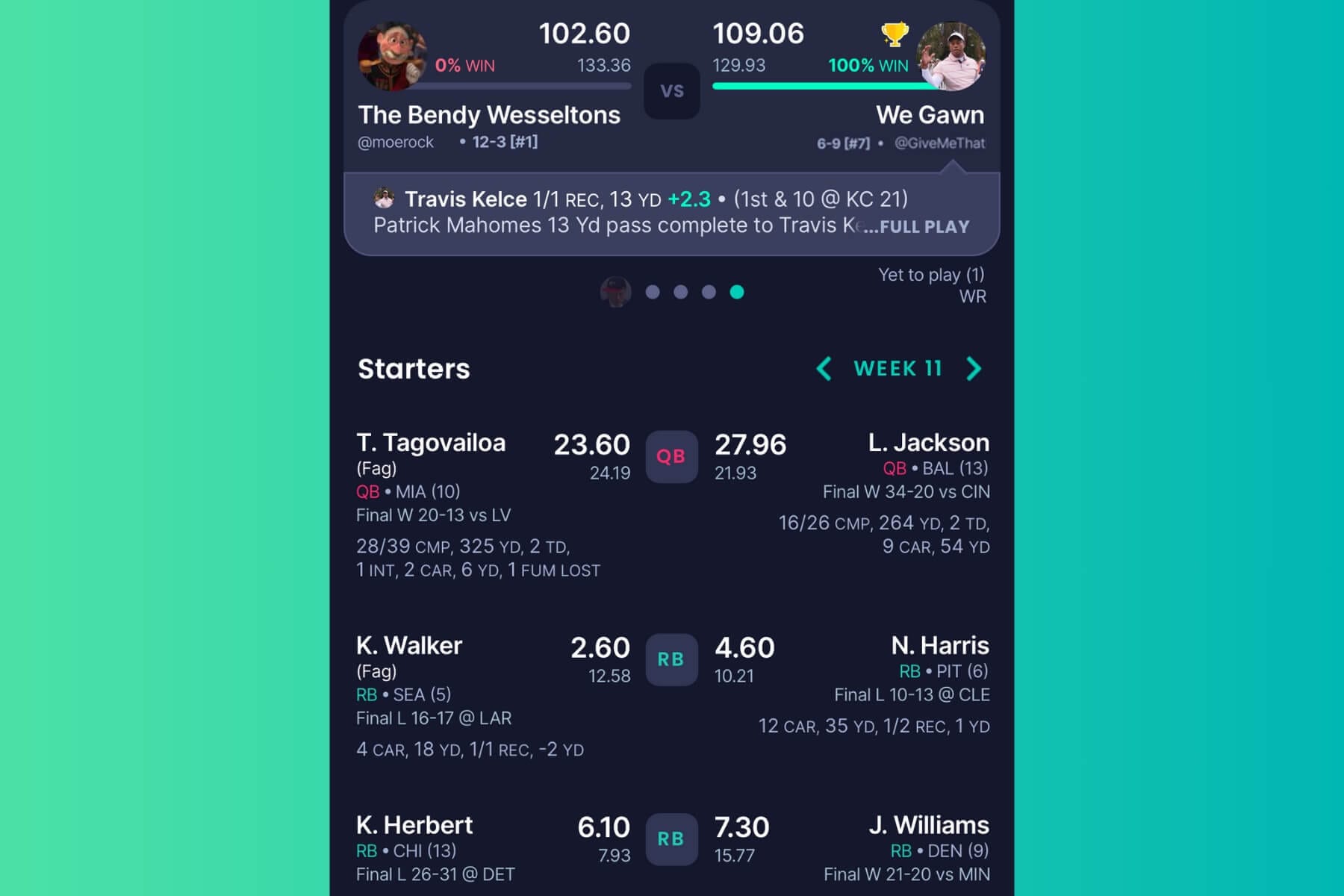
Best Ball
You’d be hard-pressed to find a fantasy football enthusiast who does not enjoy drafting. For many, the draft itself is the absolute best part of the entire experience. Best ball is a league format designed for the draft junkies.
In this format, rather than making start-sit decisions each week, proposing trades, and submitting waiver claims during the season — also known as roster management — you simply draft a team and watch it score fantasy points. After the draft concludes, you have no further responsibilities until next season.
Occasionally you’ll find best ball leagues that allow weekly roster management, but those leagues are much less common.
Additional League Formats
You may also hear mention of formats like rotisserie (roto) or total points. While these league formats exist, they are rare in the fantasy football space and much more common in fantasy baseball and basketball.
Roto leagues award points by categories (i.e. passing TDs, rushing TDs, etc.) over the course of the season and the team with the best aggregate score across categories wins. Similarly, in total points leagues, your team’s success depends on how many points you rack up over the year rather than in a week-by-week format.
Where Can You Play Fantasy Football?
While fantasy football leagues first began with pen, paper, and dozens of weekly landline phone calls (seriously), today there’s a plethora of great options on your phone, tablet, or computer.
From Sleeper to the official NFL website, there’s no shortage of ways to get started playing fantasy football. Download the Sleeper app to learn more about joining a free Fantasy Football league.
What Is Fantasy Football DFS?
For aspiring fantasy football managers who aren’t ready to commit to the grind of a full season, there is an alternative format called DFS (daily fantasy sports). In DFS, you can enter a daily fantasy picking contest with real money. It is a skill-based game where you select two or more players on a given day and select whether they will score "more" or "less" than their projected stats in the games they play that day.
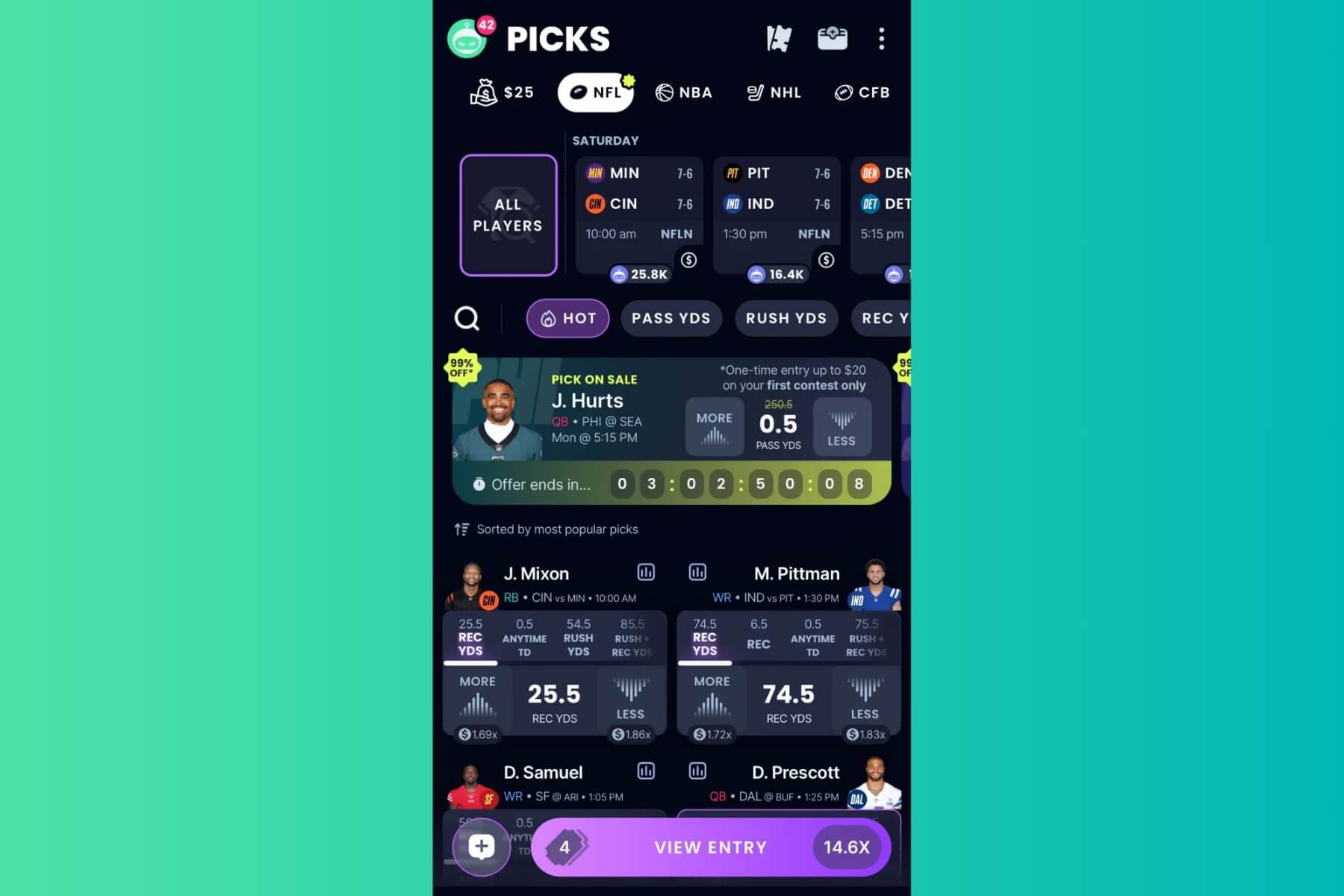
There is a wide variety of DFS games and contests available, but one popular format is Sleeper Picks. Choose a small handful of players and pick whether or not each of them will score more or less than their projected output that day. If you pick correctly, you win real money.
Learn more about Sleeper Picks.
What Is a Fantasy Football Draft?

We’ve danced around the concept of the fantasy football draft, but by now you’re officially ready to learn about the different types of drafts. Fortunately for new players, the first draft type below is used in more than 90% of leagues, though it’s still helpful to be aware of the other two types.
Fantasy Football Draft Types
Snake (Standard)
Nearly all fantasy drafts are snake drafts, where the draft order “snakes” back and forth between rounds. If you’re in a 10-team league, for example, then the team that picks first in Round 1 will pick last in Round 2. If you held the second pick in Round 1, then you’d have the second to last pick in Round 2, the second pick in Round 3, snaking back to the second to last pick in Round 4, and so on.
Snake drafts attempt to mitigate the disadvantage of having a low first round pick. The main downsides to snake drafts are the long wait times between picks and the slight advantage given to fantasy managers with the high picks in Round 1, a problem addressed by the next draft type.
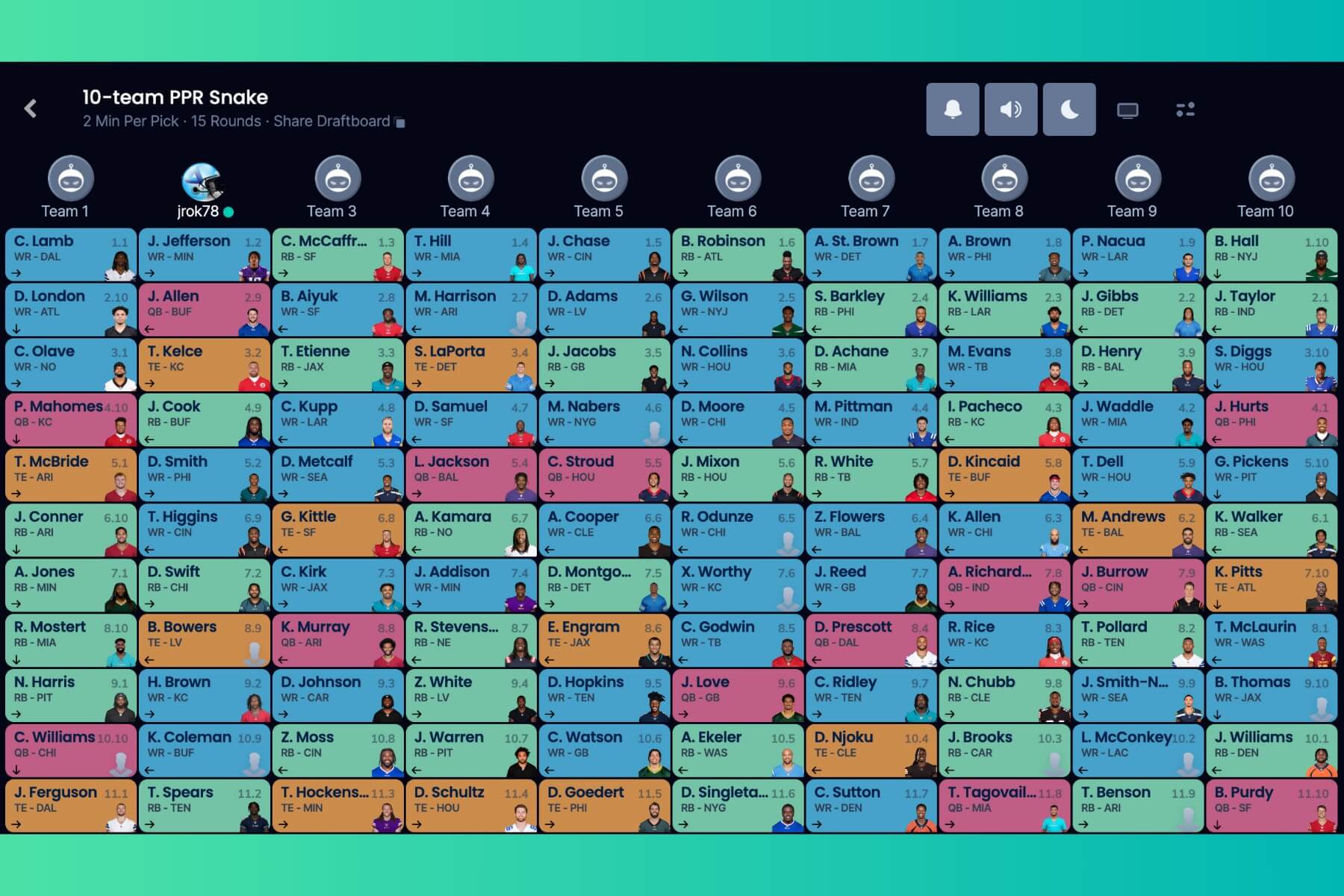
3rd Round Reversal
This type of draft is identical to a snake draft through two rounds, before a slight wrinkle in Round 3. In snake drafts, the manager who picked first in Round 1 picks first again in Round 3. But 3rd round reversal drafts flip the snake draft order in Round 3, letting the manager with the last pick of Round 1 take the first pick of Round 3. The snake process continues normally afterwards, as this concept was designed to make fantasy drafts fairer to those with later Round 1 picks.
Auction
Some fantasy managers have certain players they need to have on their teams. Or, they just want an added layer of strategy. Auction drafts deliver both capabilities.
Like a snake draft, there’s an order in auction drafts, too. However, when it’s your “turn,” you don’t have an exclusive right to make a pick, but rather a chance to make an opening bid on any player. Every other participant in the draft also has the option to bid on that player, driving up the price of each player to the highest bidder. Each manager has a set budget of fictional money, and they take turns nominating players for auction until their rosters are full.
It’s best if we use an example here. Let’s say your league gives every manager a $200 budget for the auction draft. You decide you must have quarterback Patrick Mahomes on your team so you make the highest bid and get him for $25. Congrats, you got a franchise QB. Now you have to draft the rest of your team with the remaining $175.
It’s fairly easy to see how complex auction draft strategies can become, as you fight to maximize talent with finite financial resources (just like a real NFL GM). Every person in an auction draft can bid on, and potentially win, a player at every single pick, so there are no breaks during auction drafts.
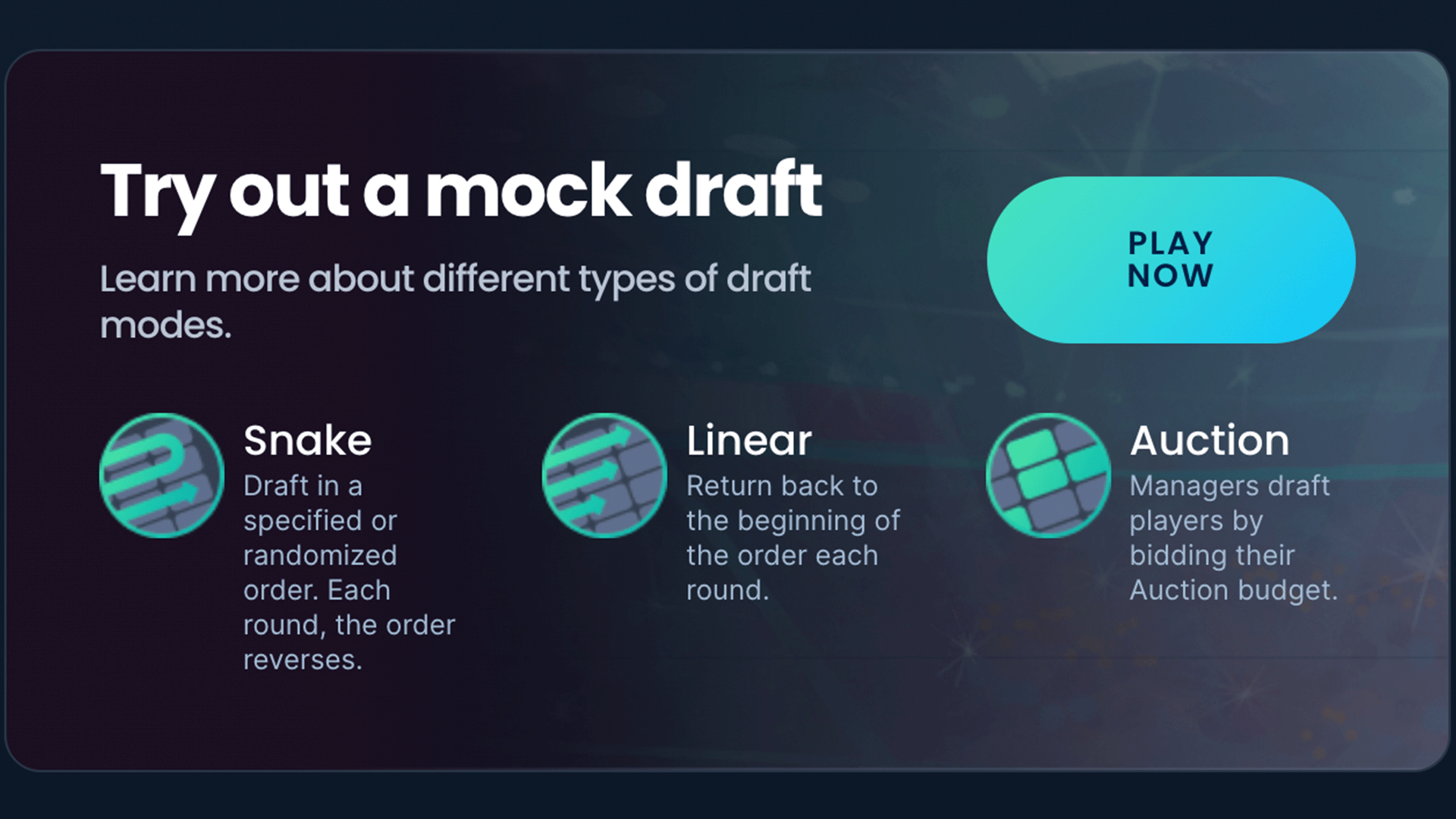
Determining Draft Order
For the draft types above, the first step is always deciding who gets which pick in the draft. There is no wrong way to choose, but popular options range from drawing numbers out of a hat to pitting league participants against each other in trivia or a round of golf. Fighting over who gets the first pick in the draft is all part of the fun.
Fantasy Football Scoring Systems
The vast majority of fantasy football scoring focuses on two high-level categories: yards and touchdowns. If a player scores a 10-yard touchdown in an NFL game, you’d receive fantasy points for the yardage and the touchdown.
While fantasy football leagues can have slight scoring differences, they’re generally built upon the Standard Scoring system. Don’t worry, your fantasy football platform of choice will make these calculations for you. No math is involved on your end!
Standard Scoring
While most leagues today have some form of customizations, the standard or traditional scoring system is the common starting point from which most leagues determine their points allocation.
Note: Standard scoring leagues may or may not use decimal point scoring, depending on league rules.
Passing
- 25 passing yards = 1 fantasy point (0.04 fantasy points per passing yard)
- Passing touchdown = 4 fantasy points each
- Fumbles lost or interceptions = -2 fantasy points each
Rushing and Receiving
- 10 rushing or Receiving Yards = 1 fantasy point (0.1 fantasy points per yard)
- Rushing or Receiving Touchdown = 6 fantasy points each
- Fumbles Lost = -2 fantasy points each
Kicking
- Extra Point: 1 fantasy point
- 0-39 Yard Field Goals: 3 fantasy points
- 40-49 Yard Field Goals: 4 fantasy points
- 50+ Yard Field Goals: 5 fantasy points
Defense & Special Teams (often abbreviated DST)
- Fumble Recovery, Interception, or Blocked Kick: 2 fantasy points each
- Sack: 1 fantasy point
- Safety: 2 fantasy points
- Defensive Touchdown: 6 fantasy points
Points Per Reception (PPR)
As the NFL evolves more towards pass-first offenses, PPR leagues are an increasingly common fantasy scoring format. PPR scoring gives an extra fantasy point for each catch a player makes. Many leagues also use half-PPR scoring, in which players get 0.5 fantasy points per reception.
By inflating the value of pass-catching Running Backs, Tight Ends and possession Wide Receivers, PPR leagues significantly influence drafting and player acquisition strategy.
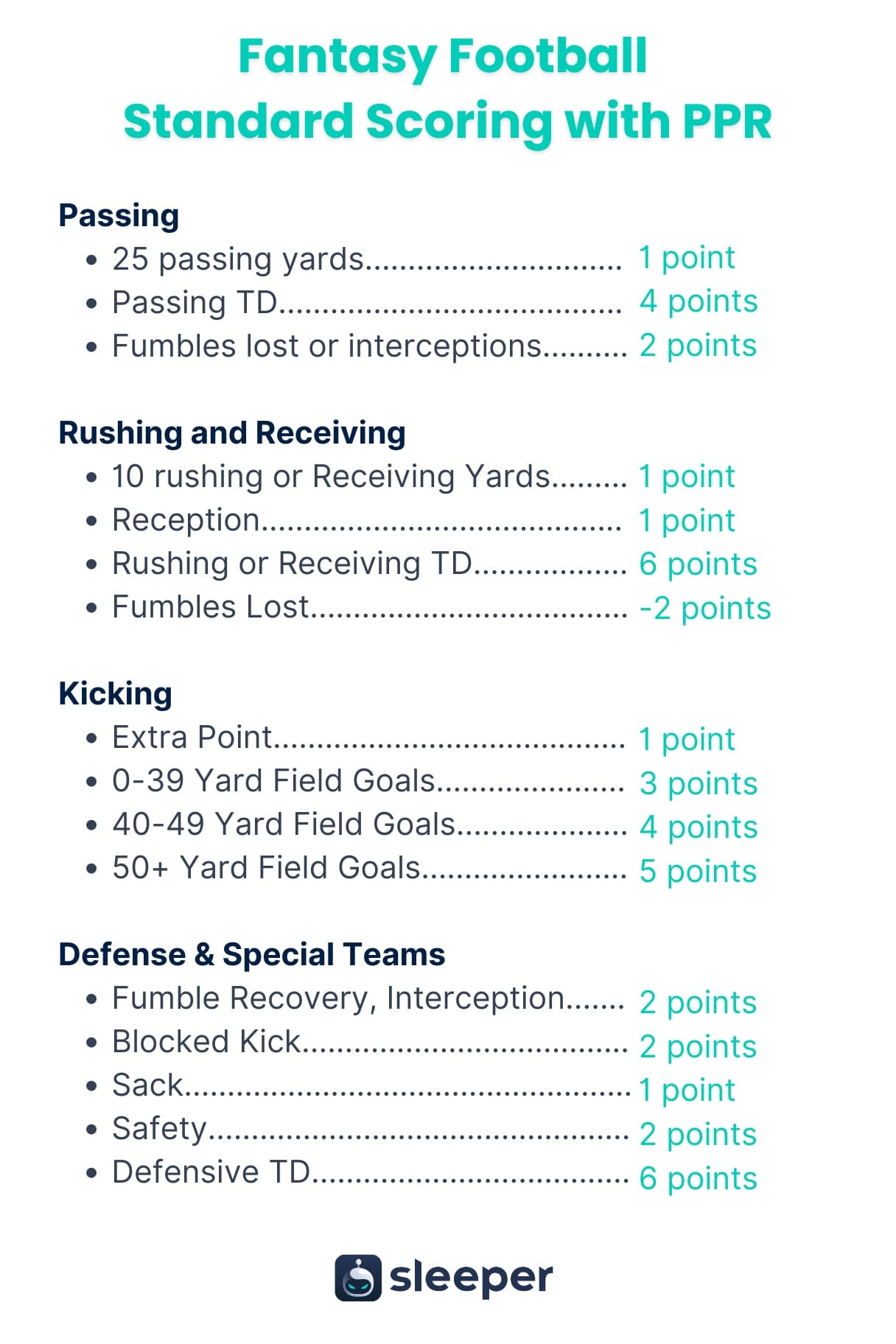
Fantasy Football Scoring Variations
As you can see in the examples below, different scoring rules can greatly influence drafting strategy and the value of different types of players.
Individual Defensive Player (IDP)
While most fantasy leagues let you draft a full team’s defense, a growing number of leagues let you draft individual defensive players instead. However, there isn’t a standard system yet for how to score their sacks, interceptions, and tackles.
Tight End Premium
Tight ends generally score fewer fantasy points than the other positions, so some leagues allocate an extra half or full fantasy point for each reception to tight ends.
Fantasy Point Bonuses
Some leagues award fantasy points for first downs or long touchdowns (over 50 yards) Bonus points for 100 yards receiving or rushing is another common variant. There are no shortage of ways to customize your scoring settings to fit your league, and platforms like Sleeper allow you to edit and adjust these settings in seconds.
Read more: Beginner's Guide to Fantasy Football Scoring Systems
Rosters and Lineups: All the Requirements
We’ve discussed how most fantasy football drafts are roughly 15 rounds. But you won’t actually start 15 players each week. This is where the infamous start-sit decisions come into play.
Common Starting Lineup in Fantasy Football
Most fantasy football leagues require a starting lineup that looks something like this:
- 1 Quarterback (QB)
- 2 Running Backs (RB)
- 2 Wide Receivers (WR)
- 1 Tight End (TE)
- 1 Flex (RB, WR, or TE)
- 1 Kicker (K)
- 1 Team Defense (DST)
Seeing a realistic fantasy lineup with real player names can help you visualize this arrangement.
- QB Patrick Mahomes
- RB Saquon Barkley
- RB Alvin Kamara
- WR Ja’Marr Chase
- WR George Pickens
- TE Mark Andrews
- FLEX Terry McLaurin
- K Justin Tucker
- DST San Francisco 49ers
That’s nine starting lineup spots to score fantasy points, which means the remaining six players on your roster occupy your fantasy bench. You’ll also have one or two spots to stash injured players. Starting spots are limited and locked after kickoff of the first game, so making the right call about who to play is one of the central challenges of the game.
Start-Sit Explained
Using the above roster, let’s review a hypothetical scenario. Perhaps WR Terry McLaurin is dealing with a mild ankle sprain and facing a tough defense in Week 5. Any RB, WR, or TE on your fantasy bench can be swapped in for Week 5, instead. Should you make that switch, McLaurin’s Week 5 fantasy points would no longer count towards your weekly total, but his replacement at FLEX would now be eligible to help your team on the fantasy scoreboard.
Every week during the NFL season, you’ll have tough decisions like this to make with your starting lineup. Some weeks your research will lead you to the right choice, making you feel like a fantasy genius. While other weeks, you’ll leave players on your fantasy bench who score touchdowns that you don’t get credit for, preventing you from winning. That’s just the nature of the beast. Start-sit decisions require a mix of luck and skill, but they always deliver a good source of trash talk on your fantasy football league’s group chat.
How Do Waivers Work in Fantasy Football?
Football is unpredictable, and every season, NFL players unexpectedly break out. Some of these breakouts are players who weren’t even selected during the initial fantasy football draft. Meanwhile, sometimes great players get hurt or have unproductive years. Thankfully, each week during the season, you’ll have access to the Waiver Wire to perform adds and drops. An underperforming player on your fantasy bench can be dropped in and replaced by a free agent who you view as having better fantasy point potential. This means keeping up with all the latest breaking news.
Waiver Methods
Priority
There are several ways leagues can handle waivers, with the simplest being waiver priority. Teams that have most recently used a waiver claim to shake up their roster move to the back of the priority list. If two fantasy managers both want to add the same player, whoever has the higher priority gets the successful waiver claim. Priority is also sometimes determined by reverse standings order, where the team with the worst record in the standings gets the highest priority when multiple managers claim a player..
Free Agent Auction Budget (FAAB)
In this format, much like an auction draft, each team gets a certain amount of FAAB dollars – usually $100 – to allocate toward free agents over the course of the season. In Sleeper leagues, waiver claims use a blind bidding process where fantasy managers can't see what others are willing to bid when they try to pick up free agents from waivers each week. The highest bidder for each player wins the claim!
If you’re really desperate to add a player off the waiver wire, you can spend a big chunk of your FAAB dollars on him. For example, if two managers bid on the same running back, and one bids $22 while the other bids $18, then the manager who bid $22 wins that player, dropping their FAAB budget from $100 to $78 for the rest of the season. FAAB is a wrinkle that adds strategy each week to your fantasy football league. Be careful not to spend your money all in one place.
How Do Fantasy Football Trades Work?
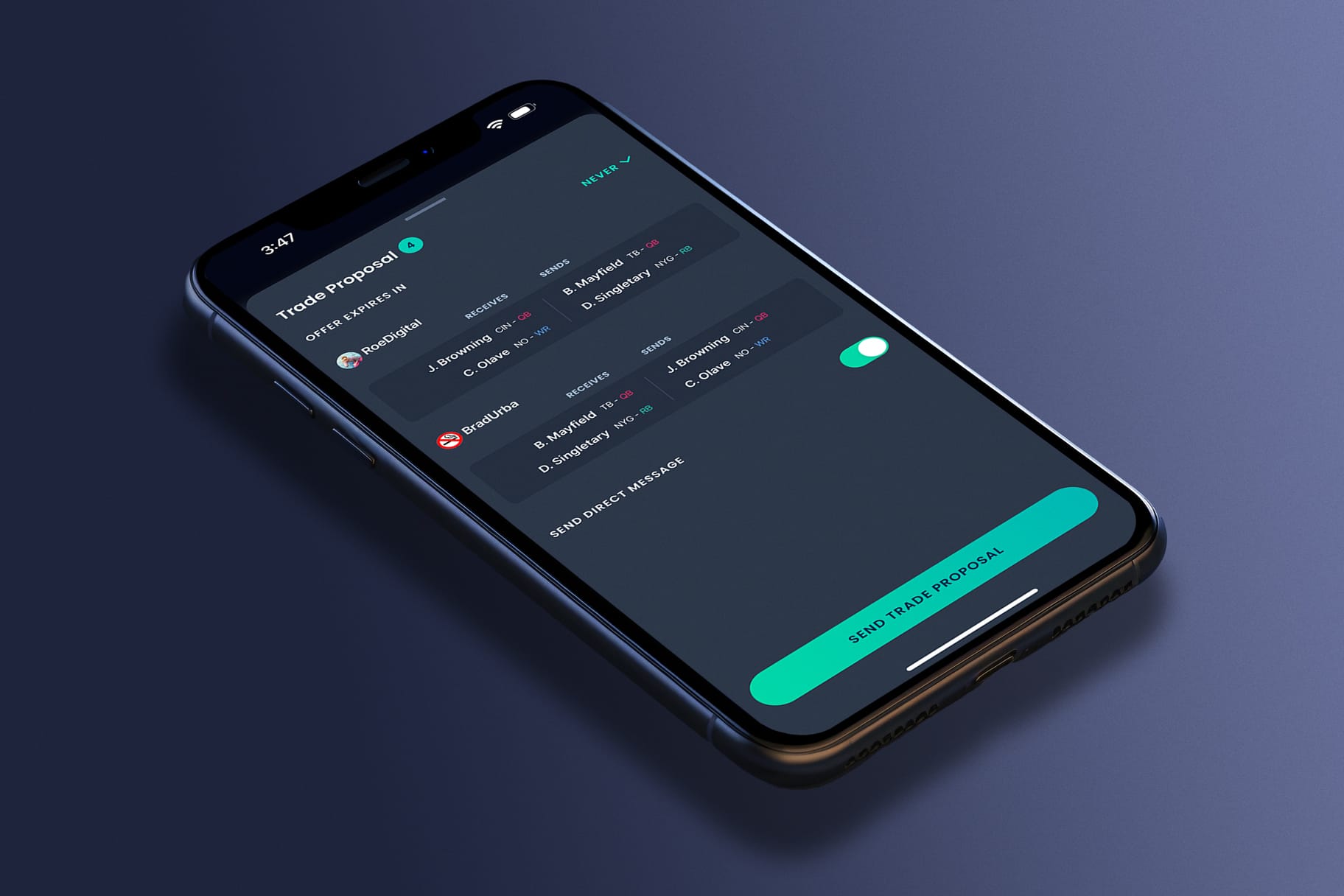
We’ve covered start-sit decisions and waivers as ways to change or update your starting lineup during the season. But there is another type of personnel move some would consider the most fun and interesting way to improve your roster. We’re talking about fantasy trades.
Trading is most easily understood with a simple thought experiment.
Your team’s starting QB gets injured in Week 2 and will be out for seven weeks. There are no good fantasy QBs on your bench or available on the waiver wire. However, a league mate of yours has a strong fantasy QB on the bench, and is also suffering from less than stellar running back output. It just so happens that you have a lot of depth at RB. The time is ripe to cut a deal.
You propose a trade to get their backup QB in exchange for one of the RBs on your bench. If the other fantasy manager accepts the trade, then the QB and RB change teams. If the opposing manager rejects the trade, nothing happens and you go back to the drawing board. But whenever a trade is proposed, the receiving manager also has the right to make a counter offer. This is where the haggling comes in.
Finding trade partners where you can create mutually beneficial offers is a borderline art form and may involve some creative negotiation. When done correctly, a good trade can impact your fantasy football team significantly. Trading is also one of the great ways to flex your fantasy genius by fleecing an opponent with a shrewd move where you get the better end of the bargain.
Fantasy Football Frequently Asked Questions
If I don’t watch football games each week, can I still play and understand fantasy football?
Many people who play fantasy football don’t watch or need to watch NFL games. Every fantasy football platform provides user-friendly fantasy point projections for every player each week. Even if you didn’t watch Patrick Mahomes’ big game the week before, you could still see that he’s projected for more fantasy points that upcoming week than any other QB on your bench or on the waiver wire. Watching the action on the field is entirely up to you.
Do you make money playing fantasy football?
While the main objective of fantasy football is to have fun and build social connections, there are also ways to make money. Many fantasy football leagues have an entry fee, from which the first and second place fantasy managers will collect a reward at the end of the season. There are also expensive fantasy football leagues for the public, where you can compete against the masses for large prizes. However, we’d recommend only spending what you can afford to lose, since there’s always an element of luck involved.
Alternatively, you can also engage in a Daily Fantasy Sports (DFS) game such as Sleeper Picks, where you put up an entry fee to play, and then pick whether several individual players will score more or less than their projected points total. If your more/less picks are correct, you’re eligible to receive several times your entry fee back as a payout.
Can you cheat at fantasy football?
There will always be cheaters in any game of skill, but cheating in fantasy football is very difficult to pull off. Most fantasy platforms have built-in features to ensure fantasy trades aren’t lopsided, and once a game begins, the players in that game lock into their lineup positions. So, if a player on your fantasy bench scores a touchdown two minutes into the game, it’s officially too late to swap him into your starting lineup.
Get Started Playing Fantasy Football with Sleeper
Congrats on making it through your first fantasy football guide, where hopefully you learned some of the basics. From fantasy football leagues to different draft types and scoring formats, you’re now better prepared to begin a memorable journey into fantasy football.
We encourage you to join millions of monthly users on Sleeper, the fastest-growing fantasy football platform. It’s completely free (seriously) to start a fantasy league on Sleeper, and the interface is slick and user-friendly.
Download the free Sleeper app or sign up on the Sleeper website homepage.
